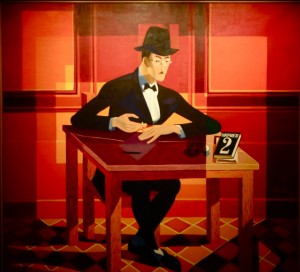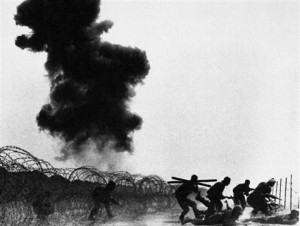Note: This novel was nominated for the Arab Booker Prize.
Eat your chocolate, little girl;
Eat your chocolate!
Believe me, there are no metaphysics in the world beyond chocolate;
Believe me, all the religions in the world do not teach more than the sweetshop.
Eat, dirty girl, eat!— “The Tobacco Shop” by Fernando Pessoa
 In this complex, challenging, and unconventional novel, Iraqi author Ali Bader takes on nothing less than the ethnic and political history of the Middle East from 1926 – 2006 for his scope. An unnamed Iraqi writer, whose life parallels that of the author in many ways, has been asked by USA Today News to ghostwrite a 1000-word article about the murder of Kamal Medhat, an eighty-year-old Iraqi violinist whose body has recently been found. Because Baghdad is so dangerous and so risky for westerners, the speaker will do the investigatory work there, but the finished story will appear under the name of John Barr, one of USA Today’s senior correspondents, a common practice for western news media these days, the writer explains. The Press Cooperation Agency and AC Media & News group also want a full-length biography of Kamal Medhat, however, and they will pay all the speaker’s expenses and supply him with files and documents for the eventual biography which he will write under his own name. As a result of this support, the writer will stay in Baghdad’s Green Zone for a month; in Tehran where the violinist stayed on several different occasions, before going to Moscow, where the writer will also go; and in Damascus where the writer spends another two months of research. What he discovers about the murdered violinist’s life becomes the main narrative of this book.
In this complex, challenging, and unconventional novel, Iraqi author Ali Bader takes on nothing less than the ethnic and political history of the Middle East from 1926 – 2006 for his scope. An unnamed Iraqi writer, whose life parallels that of the author in many ways, has been asked by USA Today News to ghostwrite a 1000-word article about the murder of Kamal Medhat, an eighty-year-old Iraqi violinist whose body has recently been found. Because Baghdad is so dangerous and so risky for westerners, the speaker will do the investigatory work there, but the finished story will appear under the name of John Barr, one of USA Today’s senior correspondents, a common practice for western news media these days, the writer explains. The Press Cooperation Agency and AC Media & News group also want a full-length biography of Kamal Medhat, however, and they will pay all the speaker’s expenses and supply him with files and documents for the eventual biography which he will write under his own name. As a result of this support, the writer will stay in Baghdad’s Green Zone for a month; in Tehran where the violinist stayed on several different occasions, before going to Moscow, where the writer will also go; and in Damascus where the writer spends another two months of research. What he discovers about the murdered violinist’s life becomes the main narrative of this book.

To call this book a murder mystery, as it is called on Amazon, is like calling Joyce’s Ulysses a travel guide to Dublin. Kamal Medhat, it turns out, is one of three completely different identities and separate cultural backgrounds used by the same man, the only common thread being his virtuosic skill at the violin, and the writer is hard pressed to follow the violinist’s trail as he moves through Iraq, Iran, Syria, Russia, and even Czechoslovakia. Yousef Sami Saleh, the earliest identity, is a Jewish resident of Baghdad from 1920 – 1953, who moved to Israel and (officially) died in 1955; Haidar Salman lived in Tehran as a Shia, then returned to Baghdad in 1958, and after a coup, escaped back to Tehran before moving to Moscow; and Kamal Medhat Mustafa, an Iraqi Baathist, had to deal with the Iran-Iraq War, the rise of Saddam Hussein, the Second Gulf War (the invasion of Kuwait), and the Third Gulf War, launched by the US. All three “identities” are the same man, married anew under each identity and the father of a son by each of his three wives.

Portrait of Fernando Pessoa by Jose de Alamada Negreiros
Author Ali Bader has long been fascinated with metaphysics and views of identity, as he has previously demonstrated in his novel Papa Sartre, and he uses the violinist’s three personas, with their different personalities, in direct parallel with the three personas used by Fernando Pessoa in his poetry book The Tobacco Shop, selections of which begin the novel and echo throughout. Pessoa considered men to be of three personality types: the keeper of flocks, the persona known in the poetry book of The Tobacco Shop as Alberto Caeiro; the protected man, known as Ricardo Reis; and the tobacconist, known as Alvaro de Campos, giving the lie to any concept of an essential “identity” since all of them are part of the identity of Fernando Pessoa himself. All of the violinist’s sons, who grow up in different countries from the violinist, also parallel the identities of Pessoa’s characters in The Tobacco Shop.

The author continues the metaphysical parallels by suggesting that similarly, three different identities pervade and overlap among the Middle Eastern countries of Iraq, Iran, and Syria, with Israel providing yet another set of characteristics and identity, and that it is these competing ideas of their own national identity which are responsible for the succession of wars among these countries. Though the US is sometimes considered responsible for the Third Gulf War in Iraq, the author also suggests that by the time that war broke out, the revolutions in both Iran and Iraq and the rise of the clerics had led to a mob mentality. “Distinctions of class had disappeared and easily manipulated groups had emerged onto the scene. The mob would march and burn and destroy with a blind, random force that knew no bounds.”

The Prague Concert Hall, where Haidar Salman plays
Carefully organized thematically, the novel is unconventional in style. The first thirty pages summarize by date the history of the Middle East, especially of Iran and Iraq, with information about the various personas of the main character, where he is, and what he is doing inserted into the chronological context. Resembling a dissertation, this section creates the feeling that this is complex non-fiction, and, though necessary for understanding the book, it is challenging to a reader unfamiliar with this history.
Some confusion also results from the fact that the journalist who is the speaker is telling a story about his search for information about Kemal Medhat. He is “reporting about,” rather than bringing a character to life the way one expects in fiction. The main character’s story feels like a biography, more than fiction, though that is also related to the fact that the speaker is a journalist, accustomed to using that style.

Battle scene from the Iran-Iraq War
The journalistic style allows the author to tell about many issues and to describe a huge number of characters as the speaker discovers information about them. Of necessity, it also means that one does not “get inside” the characters. Rather, we see how they behave (or have behaved) and figure out what it all means on our own. The author walks a fine line here among genres, since his use of parallels between the three-part main character, the three personas in Pessoa’s The Tobacco Shop, and the interconnected histories of the countries involved are needed to provide a broader, more universal thematic context than one gets in biographies. Ultimately, the author writes a novel of broad import from a unique point of view, making it understandable to the western reader despite the complexity of the historical record underlying the story. Different from the typical novel in style, this is very challenging but very rewarding to read.
ALSO by Ali Bader: PAPA SARTRE
Photos, in order: The author’s photo is from http://www.banipal.co.uk
The portrait of Fernando Pessoa by Jose de Alamada Negreiros appears on http://expatinlisbon.com
The violinist is seen here: http://www.focusonlinecommunities.com
The Prague Concert Hall, where Haidar Salman plays, is from http://www.dreamstime.com
The battle scene from the Iran-Iraq War: http://www.msnbc.msn.com
ARC: Bloomsbury Qatar
